while browsing facebook I stumbled upon a (better) blog about the way of go.
http://gogameguru.com/5-tips-dealing-unexpected-moves-go/
you can find lots of other cool stuff there:)
Dienstag, 24. Mai 2011
Mittwoch, 18. Mai 2011
Go and Power
Sometimes I feel that people think that the only thing that determines your strenght in Go is how many moves you can read ahead.
I am the living proof that this is not true:) Reading is one of the things I am very bad at. During my progression from 2d to 5d I have improved at many things but reading. Sure reading is important, but it is by far not the only thing that matters.
quote/ Miu from History's Strongest Disciple Kenichi (a manga on martial arts):

Imagine that power equals reading power in Go, I don't have much power, but I do beat strong people occasionally. There must be something else to strenght besides power. (As for me, recently I had a level-up at getting lucky, hehe.)
(Altough I know that it is unwise to reveal details of my Go – my friend wrote about his style in his blog and it was effectively used to scheme a counter strategy against him – I'll just hope that those people who would do that to me don't read this.)
I have relatively strong skills in positional judgement. Another friend pointed out that this enables me to control the flow of a game: when I think that I am ahead, I play along with my opponent, when I don't, I resist. And it might be somewhat true.
Since I am not strong at reading, I try to simplify the game whereever I can. It is the exact opposite of what most people in Dan range do on KGS, I'd like to call that technique randomizing a game. It is somehow scary to play against those people, but in around 50% of their games they just defeat themselves.
If you get the right idea of it, even if you don't have much power, this is what can happen:


Looks cool huh^^
(And this is what can happen to you too if have great power but nothing to back it up.)
I'm sorry that the post didn't turn out as informative as I had planned. I have a non-disclosure agreement with myself and cannot reveal confidential information. (Apart from the manga, all origins from my head. You probably won't find anyone else telling you the same thing. If you do, cool:) )
I am the living proof that this is not true:) Reading is one of the things I am very bad at. During my progression from 2d to 5d I have improved at many things but reading. Sure reading is important, but it is by far not the only thing that matters.
quote/ Miu from History's Strongest Disciple Kenichi (a manga on martial arts):
Imagine that power equals reading power in Go, I don't have much power, but I do beat strong people occasionally. There must be something else to strenght besides power. (As for me, recently I had a level-up at getting lucky, hehe.)
(Altough I know that it is unwise to reveal details of my Go – my friend wrote about his style in his blog and it was effectively used to scheme a counter strategy against him – I'll just hope that those people who would do that to me don't read this.)
I have relatively strong skills in positional judgement. Another friend pointed out that this enables me to control the flow of a game: when I think that I am ahead, I play along with my opponent, when I don't, I resist. And it might be somewhat true.
Since I am not strong at reading, I try to simplify the game whereever I can. It is the exact opposite of what most people in Dan range do on KGS, I'd like to call that technique randomizing a game. It is somehow scary to play against those people, but in around 50% of their games they just defeat themselves.
If you get the right idea of it, even if you don't have much power, this is what can happen:


Looks cool huh^^
(And this is what can happen to you too if have great power but nothing to back it up.)
I'm sorry that the post didn't turn out as informative as I had planned. I have a non-disclosure agreement with myself and cannot reveal confidential information. (Apart from the manga, all origins from my head. You probably won't find anyone else telling you the same thing. If you do, cool:) )
Donnerstag, 12. Mai 2011
Random sequence
time for another random move
(so, 5k again? If you don't understand the diagrams you can read and try to grasp what I wrote too.)
This is one of the first josekis I learned.
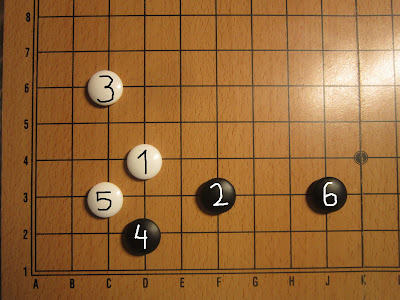
some 20 moves later...

When black plays 26 (the stone is not cut off, it's just your imagination), it would be honte for white to answer at 28. If he decides to tenuki and do nothing else, black can do this trick.

If the ladder works for black, white can only connect to the peep like this. And thus black connects underneath, robbing white off his base and white becomes what you call floating in mid-air.
Where is the ladder?
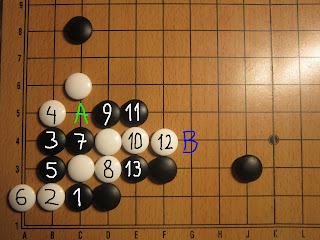
That is, when white plays kosumi-tsuke with 4 preventing black from connecting underneath. Of course black cuts with 5 and w's sagari with 6 is the tesuji for the corner's capturing race. Since black would lose the semeai if he just takes liberties, he breaks out with 7 and it becomes ugly.
Up to b 13, if the ladder at B works for black, white cannot cut with A. So when black gets to connect at B eventually, the white stones in corner die a natural and peaceful death.
But even if the ladder doesn't work for black, black can settle for an exchange by playing 13 at 11.
Nothing new so far:)
Now we change one stone in the joseki. Black extends with a keima instead of the two-point extension (6 in the very first diagram).
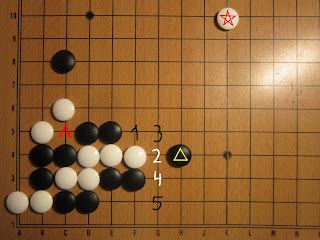
By shifting one stone, if white cuts directly at A, black can play the ladder of 12345 with the help of the triangled stone even if there is the starred white ladder breaker.
Black thinks he is smart, but there is a way for white to outwit black's plan...
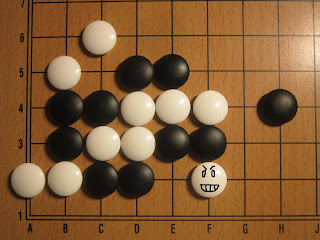
Now black should pretty much be swearing again.

Because if black connects to white's attachment, the long awaited ladder has been obliterated.
(so, 5k again? If you don't understand the diagrams you can read and try to grasp what I wrote too.)
This is one of the first josekis I learned.
some 20 moves later...
When black plays 26 (the stone is not cut off, it's just your imagination), it would be honte for white to answer at 28. If he decides to tenuki and do nothing else, black can do this trick.
If the ladder works for black, white can only connect to the peep like this. And thus black connects underneath, robbing white off his base and white becomes what you call floating in mid-air.
Where is the ladder?
That is, when white plays kosumi-tsuke with 4 preventing black from connecting underneath. Of course black cuts with 5 and w's sagari with 6 is the tesuji for the corner's capturing race. Since black would lose the semeai if he just takes liberties, he breaks out with 7 and it becomes ugly.
Up to b 13, if the ladder at B works for black, white cannot cut with A. So when black gets to connect at B eventually, the white stones in corner die a natural and peaceful death.
But even if the ladder doesn't work for black, black can settle for an exchange by playing 13 at 11.
Nothing new so far:)
Now we change one stone in the joseki. Black extends with a keima instead of the two-point extension (6 in the very first diagram).
By shifting one stone, if white cuts directly at A, black can play the ladder of 12345 with the help of the triangled stone even if there is the starred white ladder breaker.
Black thinks he is smart, but there is a way for white to outwit black's plan...
Now black should pretty much be swearing again.
Because if black connects to white's attachment, the long awaited ladder has been obliterated.
Dienstag, 10. Mai 2011
the Go player's posture
When I learned under Kobayashi Chizu sensei, she taughe us about the differences between the habits of European Go players and Japanese conventions (sitting at a Goban on a table).
From what I remember of her teachings, this should be a pretty good example:

Since the guy in the picture is right-handed, his bowl is placed at his right and the lid where prisonders are supposed to be put is in both players' field of vision (though for pros it is impolite to count the prisoners in the lid).
Furthermore you can see that the elbows are off the table, the hand is off the lid until the moment he knows where he would play and reaches for one stone from the bowl which he would place on the board in a confident way.
From my experience it is not that strict at the tournaments, but you should avoid rattling with stones or play with them making a lot of noise because it annoys approximately 100% of Go players. Except of course the one Boom! you make when putting the stone on the board.
Alright! Find 3 mistakes in this picture:

From what I remember of her teachings, this should be a pretty good example:
Since the guy in the picture is right-handed, his bowl is placed at his right and the lid where prisonders are supposed to be put is in both players' field of vision (though for pros it is impolite to count the prisoners in the lid).
Furthermore you can see that the elbows are off the table, the hand is off the lid until the moment he knows where he would play and reaches for one stone from the bowl which he would place on the board in a confident way.
From my experience it is not that strict at the tournaments, but you should avoid rattling with stones or play with them making a lot of noise because it annoys approximately 100% of Go players. Except of course the one Boom! you make when putting the stone on the board.
Alright! Find 3 mistakes in this picture:
Montag, 9. Mai 2011
endgame in another nutshell
(cont.)
dedicated to the notorious term double sente.
Double sente means the yose is sente for both players.

What's the size of the endgame in this area?

If white plays first, the sequence is sente for white.

The same goes for black. The difference between this and above diagram is 4 points (marked with the green Xs). We learned that if and endgame is sente for one player and gote for the other, the size is doubled if the gote player gets to play it because the sente player was too stupid to grab it.
As for double sente endgame, both players have the chance to get it for free, so it is hard to calculate the value.* (Someone said that it is worth infinite points.)
However, getting a double sente endgame can give you a psychological advantage. Imagine that your opponent will be all like "oh damn... I should have played that... what if I lose by 2 points now..." and become more overplay-prone.
So much for the theory!
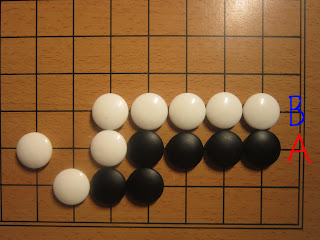
In reality, this kind of endgame is (almost) always more sente for one of the players. White A threatens the black corner (if black blocks once and tenukies, the corner is dead in ko, or alive in ko, whichever you prefer), and black B threatens to ruin white's eastside territory. In a perfect game, whoseever threat is bigger will get the endgame. In a game between two stupid humans, it is the one who is more lucky who will get it.
When you are unsure whether your opponent might tenuki your supposedly sente move (this goes for single sente moves too), there is this rule of thumb (found on senseis):
If you hope your opponent doesn't answer your move, your move is probably sente.
But keep in mind that there are situations where playing endgame too early can be bad.
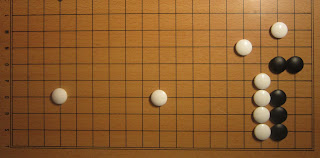
Feel the power of white's moyo!
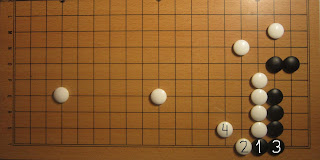
And now look how black's moves have increased white's power (in sente).
*The nerdy way to calculate is to assume that everything is gote and calculate the net value of the move and add the half size of the continuation to a gross value, and do that for both sides. However, it is probably easier to do an overall score estimation for every move than calculating that (and see rule of thumb).
dedicated to the notorious term double sente.
Double sente means the yose is sente for both players.
What's the size of the endgame in this area?
If white plays first, the sequence is sente for white.
The same goes for black. The difference between this and above diagram is 4 points (marked with the green Xs). We learned that if and endgame is sente for one player and gote for the other, the size is doubled if the gote player gets to play it because the sente player was too stupid to grab it.
As for double sente endgame, both players have the chance to get it for free, so it is hard to calculate the value.* (Someone said that it is worth infinite points.)
However, getting a double sente endgame can give you a psychological advantage. Imagine that your opponent will be all like "oh damn... I should have played that... what if I lose by 2 points now..." and become more overplay-prone.
So much for the theory!
In reality, this kind of endgame is (almost) always more sente for one of the players. White A threatens the black corner (if black blocks once and tenukies, the corner is dead in ko, or alive in ko, whichever you prefer), and black B threatens to ruin white's eastside territory. In a perfect game, whoseever threat is bigger will get the endgame. In a game between two stupid humans, it is the one who is more lucky who will get it.
When you are unsure whether your opponent might tenuki your supposedly sente move (this goes for single sente moves too), there is this rule of thumb (found on senseis):
If you hope your opponent doesn't answer your move, your move is probably sente.
But keep in mind that there are situations where playing endgame too early can be bad.
Feel the power of white's moyo!
And now look how black's moves have increased white's power (in sente).
*The nerdy way to calculate is to assume that everything is gote and calculate the net value of the move and add the half size of the continuation to a gross value, and do that for both sides. However, it is probably easier to do an overall score estimation for every move than calculating that (and see rule of thumb).
Dienstag, 3. Mai 2011
endgame thinking in a nutshell
(for the clueless endgame newbies)
Endgame, also referred to as yose, is the end of the game, as the name might suggest. In Go, the value of moves get smaller towards the end of the game. And as the game approaches the end, it becomes possible to express the value of a move in an exact number points.

what's the value of investing a move here?

to count the value of an endgame move, we compare the situation as black plays there and the situation as white plays there. Here black has 6 points and white has 5 points.

and if white plays first, black has 5 points and white has 6.
The endgame is worth 2 points (and for the more advanced, there is also a difference of 3 ko threats).

Since the endgame is gote for both sides, when you try to estimate the score you can add the two triangled stones. It means that both players have an equal chance of getting the endgame. It is pretty accurate, if you want to be more accurate, you'll have to play the endgame to the end in your head.

Next is this situation... Try to take a guess about the value of the yose first.

This situation is different from the previous one since white has to protect at 4. The sequence is sente for black.

If 4 is omitted, bad things happen.
 So we learned we have to compare the situation when black plays first to the situation when white plays first. Note that for white, the sequence is gote. The difference in territory is marked by the 3 green Xs. For black, the endgame is sente 3 points. For white it is gote 3 points, which is called reverse sente since it prevents black from playing it in sente. In this case the value is doubled (an approximation for your brain), 3 points reverse sente = 6 points gote.
So we learned we have to compare the situation when black plays first to the situation when white plays first. Note that for white, the sequence is gote. The difference in territory is marked by the 3 green Xs. For black, the endgame is sente 3 points. For white it is gote 3 points, which is called reverse sente since it prevents black from playing it in sente. In this case the value is doubled (an approximation for your brain), 3 points reverse sente = 6 points gote.

For score estimation, it is safer to assume that black gets to play his sente sequence.
to be continued
Endgame, also referred to as yose, is the end of the game, as the name might suggest. In Go, the value of moves get smaller towards the end of the game. And as the game approaches the end, it becomes possible to express the value of a move in an exact number points.
what's the value of investing a move here?
to count the value of an endgame move, we compare the situation as black plays there and the situation as white plays there. Here black has 6 points and white has 5 points.
and if white plays first, black has 5 points and white has 6.
The endgame is worth 2 points (and for the more advanced, there is also a difference of 3 ko threats).
Since the endgame is gote for both sides, when you try to estimate the score you can add the two triangled stones. It means that both players have an equal chance of getting the endgame. It is pretty accurate, if you want to be more accurate, you'll have to play the endgame to the end in your head.
Next is this situation... Try to take a guess about the value of the yose first.
This situation is different from the previous one since white has to protect at 4. The sequence is sente for black.
If 4 is omitted, bad things happen.
For score estimation, it is safer to assume that black gets to play his sente sequence.
to be continued
Montag, 2. Mai 2011
basic corner shapes
(for reaching shodan)
This shape is from a book which the author, a Taiwanese pro, gave me without asking me whether I wanted it when I attended one of his courses. (It turned out that I already had a copy at home.)

It is White to play and Black to kill White in every variation. This shape contains many basic shapes in the corner. When you have thoroughly understood each variation, including the wrong ones, the author awards you the tsumego rank of 1d. Please try it out yourself first before you read on.
>>> TRY TO SOLVE IT YOURSELF FIRST <<<
>>> NO CHEATING <<<
>>> YOU STILL HAVE A CHANCE TO GO BACK AND DO IT YOURSELF <<<
>>> ARE YOU REALLY SURE YOU DON'T WANT TO SOLVE IT YOURSELF??! <<<
Ok well, here I shall present some examples of what that shape contains. Keep in mind that those are not all variations. You are quite good if you can see the status of each group at one glance. Sorry if you had expected solutions here, you still need to solve them yourself:p






Feel free to consult me or strong players when you are unclear.
ǝuıl ʇsɹıɟ ǝɥʇ oʇ ƃuıdɯnɾ ʎq sllıʞ q )ɟ
ıɹɐɯnzǝɯɐp ʎq sllıʞ q )ǝ
ǝuɐɥ ʎq ʇou ʇnq '2-2 ʎq sǝʌıl M )p
sllıʞ ʇuǝɯǝɔɐld s'q ʇnq 'oʞ uǝɥʇ 'ǝuɐɥ ǝɥʇ sʞɔolq q ɟı )ɔ
oʞ )q
sllıʞ q 'ǝdɐɥs-ɾ ǝɥʇ )ɐ
This shape is from a book which the author, a Taiwanese pro, gave me without asking me whether I wanted it when I attended one of his courses. (It turned out that I already had a copy at home.)
It is White to play and Black to kill White in every variation. This shape contains many basic shapes in the corner. When you have thoroughly understood each variation, including the wrong ones, the author awards you the tsumego rank of 1d. Please try it out yourself first before you read on.
>>> TRY TO SOLVE IT YOURSELF FIRST <<<
>>> NO CHEATING <<<
>>> YOU STILL HAVE A CHANCE TO GO BACK AND DO IT YOURSELF <<<
>>> ARE YOU REALLY SURE YOU DON'T WANT TO SOLVE IT YOURSELF??! <<<
Ok well, here I shall present some examples of what that shape contains. Keep in mind that those are not all variations. You are quite good if you can see the status of each group at one glance. Sorry if you had expected solutions here, you still need to solve them yourself:p
Feel free to consult me or strong players when you are unclear.
ǝuıl ʇsɹıɟ ǝɥʇ oʇ ƃuıdɯnɾ ʎq sllıʞ q )ɟ
ıɹɐɯnzǝɯɐp ʎq sllıʞ q )ǝ
ǝuɐɥ ʎq ʇou ʇnq '2-2 ʎq sǝʌıl M )p
sllıʞ ʇuǝɯǝɔɐld s'q ʇnq 'oʞ uǝɥʇ 'ǝuɐɥ ǝɥʇ sʞɔolq q ɟı )ɔ
oʞ )q
sllıʞ q 'ǝdɐɥs-ɾ ǝɥʇ )ɐ
Sonntag, 1. Mai 2011
FAQ
I've been asked certain questions many times and I'm tired of answering the same every time. I will go through the most popular questions here and it should also serve the purpose of introducing myself.
Q: Hey, how are you?
A: Yeah as always, could be better, could be worse, and you?
Q: Since when do you play Go?
A: When I was young I found the Manga of Hikaru no Go at home and got interested. My father happened to know this game (he is 3k) and taught me the rules. I don't remember when it was, but you can check my tournament history, they are more interesting. I probably started some time before that.
Q: How did you reach your strenght?
A: Strenght?:) I quite suck yet, but you shall not worry. Everything I am going to post is from reliable sources. Like Books, pro games, reviews or the teachings of Chizu-sensei who used to live in my city for a while, also Mangas.
Q: Where are you from?
A: My parents came from Taiwan before I was born in Austria. I speak German, Mandarin Chinese with beautiful Taiwanese accent and English with stupid Austrian accent.
Q: What are you doing in Austria?
A: I graduated from school in 2010. Right now I study violin at a music university. I play the piano too and sometimes the organ.
Q: Are you an alcoholic?
A: Not really, even if it might seem so. I lack aldehyddehydrogenase which enables me to reach a drunken condition fast (and I'm stronger in that state).
Q: Why do you always take your towel?
A: It's useful. I've had it before I knew about the Hitchhiker's Guide to the Galaxy. So far my towel has served as: blanket, pillow, picnic rug, scarf, sunshade, rainshade, emergency nose cover, emergency beer wiping device, and furthermore also as a towel.
Q: Why don't you recognize me? TT___TT
A: Sorry, I have a bad memory for people... :p but don't worry you are not the only person I don't recognize.
Q: Hey, how are you?
A: Yeah as always, could be better, could be worse, and you?
Q: Since when do you play Go?
A: When I was young I found the Manga of Hikaru no Go at home and got interested. My father happened to know this game (he is 3k) and taught me the rules. I don't remember when it was, but you can check my tournament history, they are more interesting. I probably started some time before that.
Q: How did you reach your strenght?
A: Strenght?:) I quite suck yet, but you shall not worry. Everything I am going to post is from reliable sources. Like Books, pro games, reviews or the teachings of Chizu-sensei who used to live in my city for a while, also Mangas.
Q: Where are you from?
A: My parents came from Taiwan before I was born in Austria. I speak German, Mandarin Chinese with beautiful Taiwanese accent and English with stupid Austrian accent.
Q: What are you doing in Austria?
A: I graduated from school in 2010. Right now I study violin at a music university. I play the piano too and sometimes the organ.
Q: Are you an alcoholic?
A: Not really, even if it might seem so. I lack aldehyddehydrogenase which enables me to reach a drunken condition fast (and I'm stronger in that state).
Q: Why do you always take your towel?
A: It's useful. I've had it before I knew about the Hitchhiker's Guide to the Galaxy. So far my towel has served as: blanket, pillow, picnic rug, scarf, sunshade, rainshade, emergency nose cover, emergency beer wiping device, and furthermore also as a towel.
Q: Why don't you recognize me? TT___TT
A: Sorry, I have a bad memory for people... :p but don't worry you are not the only person I don't recognize.
Abonnieren
Posts (Atom)